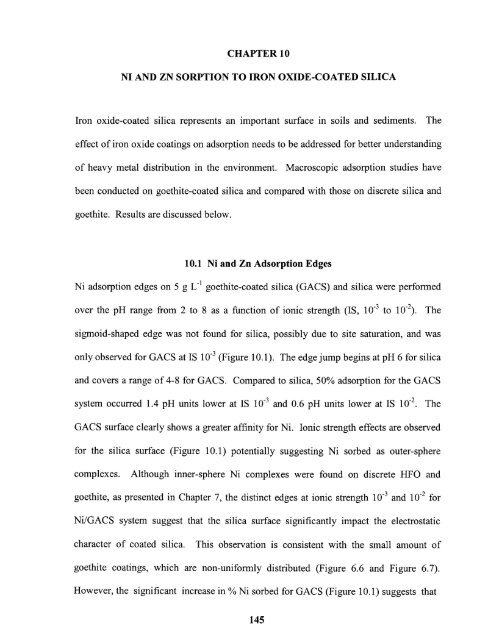Heavy metal adsorption on iron oxide and iron oxide-coated silica ...
Heavy metal adsorption on iron oxide and iron oxide-coated silica ...
Heavy metal adsorption on iron oxide and iron oxide-coated silica ...
You also want an ePaper? Increase the reach of your titles
YUMPU automatically turns print PDFs into web optimized ePapers that Google loves.
CHAPTER 10NI AND ZN SORPTION TO IRON OXIDE-COATED SILICAIr<strong>on</strong> <strong>oxide</strong>-<strong>coated</strong> <strong>silica</strong> represents an important surface in soils <strong>and</strong> sediments. Theeffect of ir<strong>on</strong> <strong>oxide</strong> coatings <strong>on</strong> <str<strong>on</strong>g>adsorpti<strong>on</strong></str<strong>on</strong>g> needs to be addressed for better underst<strong>and</strong>ingof heavy <str<strong>on</strong>g>metal</str<strong>on</strong>g> distributi<strong>on</strong> in the envir<strong>on</strong>ment. Macroscopic <str<strong>on</strong>g>adsorpti<strong>on</strong></str<strong>on</strong>g> studies havebeen c<strong>on</strong>ducted <strong>on</strong> goethite-<strong>coated</strong> <strong>silica</strong> <strong>and</strong> compared with those <strong>on</strong> discrete <strong>silica</strong> <strong>and</strong>goethite. Results are discussed below.10.1 Ni <strong>and</strong> Zn Adsorpti<strong>on</strong> EdgesNi <str<strong>on</strong>g>adsorpti<strong>on</strong></str<strong>on</strong>g> edges <strong>on</strong> 5 g L -1 goethite-<strong>coated</strong> <strong>silica</strong> (GACS) <strong>and</strong> <strong>silica</strong> were performedover the pH range from 2 to 8 as a functi<strong>on</strong> of i<strong>on</strong>ic strength (IS, 10 -3 to 10-2). Thesigmoid-shaped edge was not found for <strong>silica</strong>, possibly due to site saturati<strong>on</strong>, <strong>and</strong> was<strong>on</strong>ly observed for GACS at IS 10 -3 (Figure 10.1). The edge jump begins at pH 6 for <strong>silica</strong><strong>and</strong> covers a range of 4-8 for GACS. Compared to <strong>silica</strong>, 50% <str<strong>on</strong>g>adsorpti<strong>on</strong></str<strong>on</strong>g> for the GACSsystem occurred 1.4 pH units lower at IS 10 -3 <strong>and</strong> 0.6 pH units lower at IS 10 -2. TheGACS surface clearly shows a greater affinity for Ni. I<strong>on</strong>ic strength effects are observedfor the <strong>silica</strong> surface (Figure 10.1) potentially suggesting Ni sorbed as outer-spherecomplexes. Although inner-sphere Ni complexes were found <strong>on</strong> discrete HFO <strong>and</strong>goethite, as presented in Chapter 7, the distinct edges at i<strong>on</strong>ic strength 10 -3 <strong>and</strong> 10-2 forNi/GACS system suggest that the <strong>silica</strong> surface significantly impact the electrostaticcharacter of <strong>coated</strong> <strong>silica</strong>. This observati<strong>on</strong> is c<strong>on</strong>sistent with the small amount ofgoethite coatings, which are n<strong>on</strong>-uniformly distributed (Figure 6.6 <strong>and</strong> Figure 6.7).However, the significant increase in % Ni sorbed for GACS (Figure 10.1) suggests that145
















